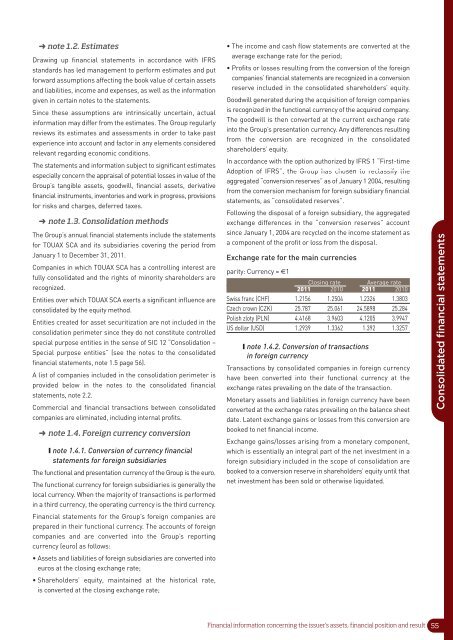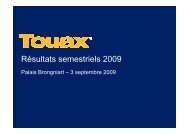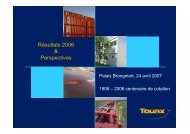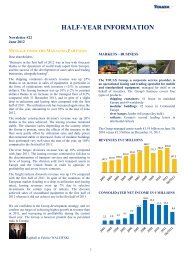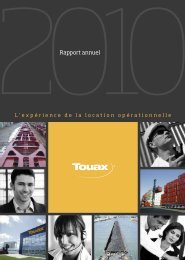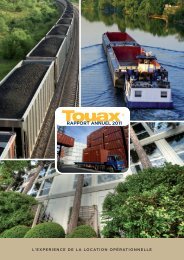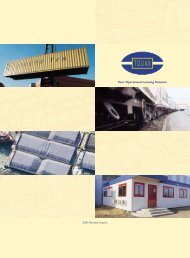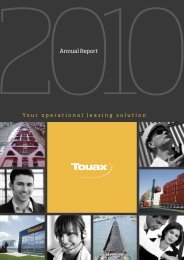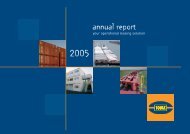2011 Annual report - touax group
2011 Annual report - touax group
2011 Annual report - touax group
You also want an ePaper? Increase the reach of your titles
YUMPU automatically turns print PDFs into web optimized ePapers that Google loves.
➜ note 1.2. Estimates<br />
Drawing up financial statements in accordance with IFRS<br />
standards has led management to perform estimates and put<br />
forward assumptions affecting the book value of certain assets<br />
and liabilities, income and expenses, as well as the information<br />
given in certain notes to the statements.<br />
Since these assumptions are intrinsically uncertain, actual<br />
information may differ from the estimates. The Group regularly<br />
reviews its estimates and assessments in order to take past<br />
experience into account and factor in any elements considered<br />
relevant regarding economic conditions.<br />
The statements and information subject to significant estimates<br />
especially concern the appraisal of potential losses in value of the<br />
Group’s tangible assets, goodwill, financial assets, derivative<br />
financial instruments, inventories and work in progress, provisions<br />
for risks and charges, deferred taxes.<br />
➜ note 1.3. Consolidation methods<br />
The Group’s annual financial statements include the statements<br />
for TOUAX SCA and its subsidiaries covering the period from<br />
January 1 to December 31, <strong>2011</strong>.<br />
Companies in which TOUAX SCA has a controlling interest are<br />
fully consolidated and the rights of minority shareholders are<br />
recognized.<br />
Entities over which TOUAX SCA exerts a significant influence are<br />
consolidated by the equity method.<br />
Entities created for asset securitization are not included in the<br />
consolidation perimeter since they do not constitute controlled<br />
special purpose entities in the sense of SIC 12 “Consolidation –<br />
Special purpose entities” (see the notes to the consolidated<br />
financial statements, note 1.5 page 56).<br />
A list of companies included in the consolidation perimeter is<br />
provided below in the notes to the consolidated financial<br />
statements, note 2.2.<br />
Commercial and financial transactions between consolidated<br />
companies are eliminated, including internal profits.<br />
➜ note 1.4. Foreign currency conversion<br />
❙ note 1.4.1. Conversion of currency financial<br />
statements for foreign subsidiaries<br />
The functional and presentation currency of the Group is the euro.<br />
The functional currency for foreign subsidiaries is generally the<br />
local currency. When the majority of transactions is performed<br />
in a third currency, the operating currency is the third currency.<br />
Financial statements for the Group’s foreign companies are<br />
prepared in their functional currency. The accounts of foreign<br />
companies and are converted into the Group’s <strong>report</strong>ing<br />
currency (euro) as follows:<br />
• Assets and liabilities of foreign subsidiaries are converted into<br />
euros at the closing exchange rate;<br />
• Shareholders’ equity, maintained at the historical rate,<br />
is converted at the closing exchange rate;<br />
• The income and cash flow statements are converted at the<br />
average exchange rate for the period;<br />
• Profits or losses resulting from the conversion of the foreign<br />
companies’ financial statements are recognized in a conversion<br />
reserve included in the consolidated shareholders’ equity.<br />
Goodwill generated during the acquisition of foreign companies<br />
is recognized in the functional currency of the acquired company.<br />
The goodwill is then converted at the current exchange rate<br />
into the Group’s presentation currency. Any differences resulting<br />
from the conversion are recognized in the consolidated<br />
shareholders’ equity.<br />
In accordance with the option authorized by IFRS 1 “First-time<br />
Adoption of IFRS”, the Group has chosen to reclassify the<br />
aggregated “conversion reserves” as of January 1 2004, resulting<br />
from the conversion mechanism for foreign subsidiary financial<br />
statements, as “consolidated reserves”.<br />
Following the disposal of a foreign subsidiary, the aggregated<br />
exchange differences in the “conversion reserves” account<br />
since January 1, 2004 are recycled on the income statement as<br />
a component of the profit or loss from the disposal.<br />
Exchange rate for the main currencies<br />
parity: Currency = €1<br />
Closing rate Average rate<br />
<strong>2011</strong> 2010 <strong>2011</strong> 2010<br />
Swiss franc (CHF) 1.2156 1.2504 1.2326 1.3803<br />
Czech crown (CZK) 25.787 25.061 24.5898 25.284<br />
Polish zloty (PLN) 4.4168 3.9603 4.1205 3.9947<br />
US dollar (USD) 1.2939 1.3362 1.392 1.3257<br />
❙ note 1.4.2. Conversion of transactions<br />
in foreign currency<br />
Transactions by consolidated companies in foreign currency<br />
have been converted into their functional currency at the<br />
exchange rates prevailing on the date of the transaction.<br />
Monetary assets and liabilities in foreign currency have been<br />
converted at the exchange rates prevailing on the balance sheet<br />
date. Latent exchange gains or losses from this conversion are<br />
booked to net financial income.<br />
Exchange gains/losses arising from a monetary component,<br />
which is essentially an integral part of the net investment in a<br />
foreign subsidiary included in the scope of consolidation are<br />
booked to a conversion reserve in shareholders’ equity until that<br />
net investment has been sold or otherwise liquidated.<br />
Consolidated financial statements<br />
Financial information concerning the issuer’s assets, financial position and result<br />
55


